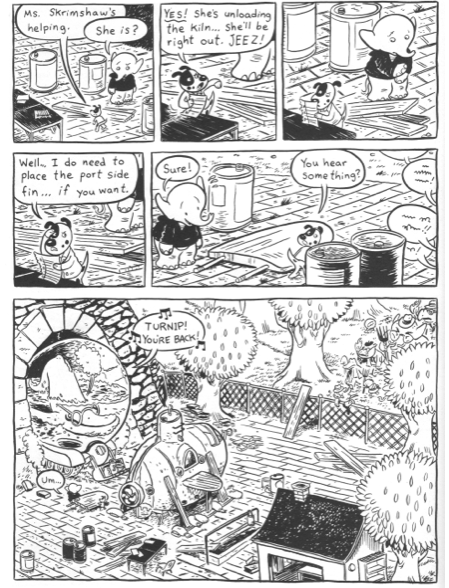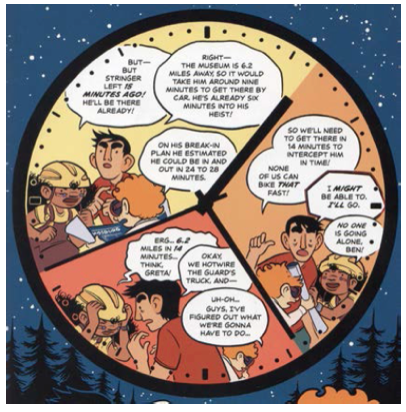Comics in the Classroom: Why Comics?
Throughout the month of August, Teach.com and Reading With Pictures are bringing you Comics in the Classroom, a blog series about using comics in education, including why graphic novels are complex texts as defined by the Common Core Standards, how to use graphic texts to teach in the content areas, how and where to find the best graphic texts, and more. We hope you’ll join us and bring the power of comics to your classroom!
The following guest post is written by Tracy Edmunds, M.A., Curriculum Manger at Reading With Pictures
“It always strikes me as supremely odd that high culture venerates the written word on the one hand, and the fine visual arts on the other. Yet somehow putting the two together is dismissed as juvenilia. Why is that? Why can’t these forms of art go together like music and dance?” — Jonathan Hennessey, Author of The U.S. Constitution: A Graphic Adaptation and The Gettysburg Address: A Graphic Adaptation
When I was in school, kids would slip comics inside their textbooks to read on the side. Comics were considered recreational reading at best, but usually adults saw them as mind-numbing tripe. You certainly would never have seen one used in instruction. Times have changed, and as comics and graphic novels become more accepted as a legitimate form of art and literature, they are making their way into classrooms. Many parents and teachers, however, still remember the stigma that comics had when they were young and are asking, “Why should kids read comics?”
When I was in school, kids would slip comics inside their textbooks to read on the side. Comics were considered recreational reading at best, but usually adults saw them as mind-numbing tripe. You certainly would never have seen one used in instruction. Times have changed, and as comics and graphic novels become more accepted as a legitimate form of art and literature, they are making their way into classrooms. Many parents and teachers, however, still remember the stigma that comics had when they were young and are asking, “Why should kids read comics?”
Emerging research shows that comics and graphic novels are motivating, support struggling readers, enrich the skills of accomplished readers and are highly effective at teaching sometimes dull or dry material in subject areas such as science and social studies.
Josh Elder, founder and president of Reading With Pictures, sums up the strengths of comics as educational tools with his “Three E’s of Comics.”
- Engagement: Comics impart meaning through the reader’s active engagement with written language and juxtaposed sequential images. Readers must actively make meaning from the interplay of text and images, as well as by filling in the gaps between panels.
- Efficiency: The comic format conveys large amounts of information in a short time. This is especially effective for teaching content in the subject areas (math, science, social studies, etc.).
- Effectiveness: Processing text and images together leads to better recall and transfer of learning. Neurological experiments have shown that we process text and images in different areas of the brain: known as the Dual-Coding Theory of Cognition. These experiments also indicate that pairing an image with text leads to increased memory retention for both. With comics, students not only learn the material faster, they learn it better.
Emergent, Beginning and Struggling Readers
Young children are just beginning to learn that concrete objects can be represented in different ways. For example, a dog is a furry animal that wags its tail and barks. It can be represented by a photograph of a dog, a stylized or “cartoon” illustration of a dog, or letters forming the word “dog.” Most children begin to make this transition from concrete to abstract through picture books, with a single illustration on each page. Sequential art (wordless comics) can take learning to the next level, asking kids to follow a sequence of illustrations that form a story.

Books like Owly, by Andy Runton, provide an opportunity for young children to look at the pictures in order and follow the story. They love to verbalize the story, which reinforces the concept that ink on a page can be translated into ideas and words. In addition, the characters communicate using symbols, providing another opportunity for children to make the connection between abstract images and language.
Before children are ready to read text, sequential art can give them practice in making meaning from material printed on a page, tracking left to right and top to bottom, interpreting symbols, and following the sequence of events in a story. Sequential art provides plenty of opportunity for connecting a story to children’s own experiences, predicting what will happen, inferring what happens between panels and summarizing, just as you would do with a text story. The advantage of sequential art is that children don’t need to be able to decode text to learn and practice comprehension skills.
Once a child begins to decode text, the comic format enables them to read much more complex stories than is possible with traditional text and illustration.
Imagine what this page from Spiralbound, by Aaron Renier, would look like as text:

It would take many pages of text to convey all the information in the last panel alone! With comics and graphic novels, beginning readers can enjoy more emotion, action and detail than in a typical “See Jane Run” story. When kids read enjoyable, complex and compelling stories, they are motivated to read more, so graphic novels can be great steppingstones to longer text works. This is also an advantage when encouraging struggling or reluctant readers or English learners. They can enjoy great stories and practice high-level reading comprehension skills, even at a lower text reading level.
But perhaps the most important reason that kids should read comics and graphic novels is because they want to. Many young readers, when confronted with solid pages of text, become intimidated and overwhelmed and just give up. Give the same reluctant reader a literary graphic novel like Bone by Jeff Smith or a historical work like Nathan Hale’s Hazardous Tales and they dive in eagerly, devouring every page. With many struggling readers, motivation is the key, and comics are motivating.
Accomplished Readers
Because graphic novels require readers to actively decode and comprehend both text and images and the interplay between them, students must use higher-level thinking skills such as inference and synthesis. The narrative structures that authors can create using both text and image are often different from and sometimes more complex than text alone, and while reading graphic texts, students must analyze and synthesize structures both within a page and often as a pattern throughout the book. The graphic medium also provides for novel uses of metaphor, symbolism, puns, irony and point of view.
Take for example this page from Shannon and Dean Hale’s Rapunzel’s Revenge. The creators have used a unique parallel visual structure, in combination with differing color palettes, to show the main character’s memories and relate the past to the present.

In this single panel from The Secret Science Alliance and the Copycat Crook, Eleanor Davis challenges the reader to keep up with the characters as they try to figure out the timing of their next move. Neither of these complicated narrative structures would be possible with text alone.

Graphic texts are complex, effective teaching tools because they require readers not only to passively receive information, but to interact with both text and images to construct meaning, and that is the key to the magic. Words and pictures work together!
Click here to download a summary of studies supporting the use of comics in education from Reading With Pictures.
